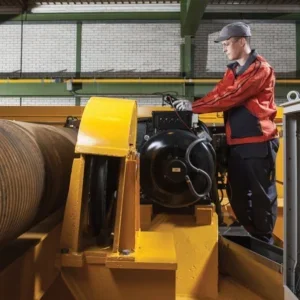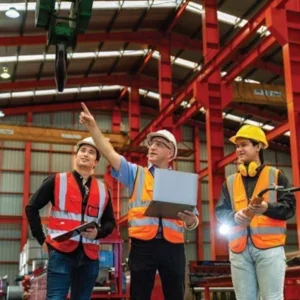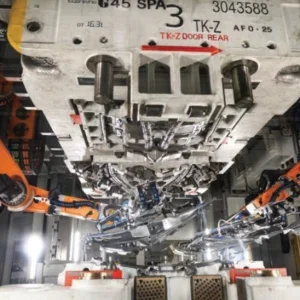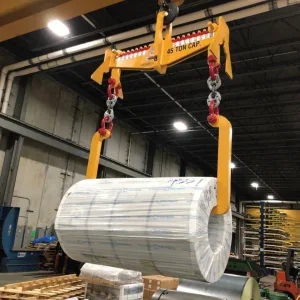Metal plating has a broader spectrum of purposes than galvanising, including enhancement of electrical or bonding properties, helping to shape or form parts or just making it look nice.
Automotive and aerospace hardware, computer chips and circuit boards, decorative jewelry, door handles and shower heads, pretty much every industry that makes parts requires metal plating.

Galvanising, by contrast, is aimed almost exclusively at protecting steel from the elements in outdoor applications. Galvanising is not ‘surface finishing’, according to the American Galvanizers Association (although the National Association for Surface Finishing counts galvanisers among its membership). Galvanising is really a corrosion protection industry, according to the AGA, although of course galvanised bridge girders certainly looks a lot nicer—as well as lasting longer—than un-galvanised steel.
Whatever you call it, it’s all metal on metal, applied in coats of molten metal or metal ions as cranes and hoists raise and lower metal parts and pieces, moving them from one bath or ‘kettle’ or ‘pot’ to another in chemical environments that can be challenging.
“Typically the galvanising industry is the most challenging one, the lifting equipment that works around and above the pickling tanks, the cleaning station of the material that eventually will be dipped into molten zinc for the galvanising process,” says Bernd Forwick, overhead crane product manager for Demag Cranes & Components. The conditions are super hot, steaming with caustic fumes and boiling with corrosive splatter.
“Chemically, it’s extremely aggressive,” he says. “They don’t call them ‘cleaning tanks’ for nothing.”
Typically, material handling starts with receiving of the raw materials to be galvanised, which if large enough are handled by overhead cranes. The materials go through the cleaning process on the pickling line, where cranes and hoists dip the materials into molten zinc, and then lifted to a cooling station. The finished material is then moved to the shipping area.

Normal industrial cranes and hoists work fine on the receiving and shipping ends of the process, but in between they need to be tougher. One trend over the years in galvanising has been a move toward faster process throughput by a transition from sulfuric to hydrochloric acid in the pickling process, Forwick says.
When major users started moving to hydrochloric acid in the early-to-mid 1990s, hydrochloric acid was the exception. Today, sulfuric acid is the exception, and sulfuric acid is equipment-friendly compared with hydrochloric, according to Forwick.
“Sulfuric acid is still aggressive, but not nearly as bad as the hydrochloric acid that’s pretty standard today in the cleaning tanks,” he says. “It requires that you choose certain materials and avoid other materials because they just don’t work.”
Demag cranes used in this environment are designed for this environment, from epoxy paint on steel structures to special execution of the control panels and wiring materials. Materials that just don’t stand up in hydrochloric acid, such as nylon, have to be eliminated from the component list. Another trend in pickling line areas of the process is toward more automation of the dipping operation, with cranes positioned automatically by production programmes.
“One of the main reasons for that is to get people out of the environment, which is nasty and got nastier by using hydrochloric acid,” Forwick says.

Demag is one of the brands most commonly used by galvanisers, and that seems to be a long tradition, Forwick says. “It seems that a lot of proprietors of galvanising companies were German immigrants, and when Demag started to market their hoists and cranes in Canada and the US, customers were basically sure that they would get the same kind of equipment they’d had in the home country,” he suggests. “Whatever Demag sold them at that time worked, because they kept coming back to us for generations. In the long run, it’s become really a market position for us.”
Lifting equipment that works in galvanising can also be used in other hot and caustic industries, “but it just so happens that galvanising is the most widespread industry that provides these environmental challenges,” Forwick says.
Yale Lift-Tech is another company often mentioned by galvanisers as a supplier of cranes and hoists, thanks at least in part to specialty features of the company’s products aimed at the industry’s requirements, according to customer service manager Brett McCleary.
“The hoists typically have to go fast as they take it from one tank to another,” he says. “You’re also doing a lot of start and stop, with the operator trying to plug something carefully into the tank so as not to make a splash.”
Yale Lift-Tech hoist advantages come from features such as mechanical load brakes, variable frequency and electronics enclosed to prevent deterioration, and hard, heat treated gearing, McCleary says.
While a hoist needs a slower speed when dipping a part into molten zinc, production speed requires it to move more quickly once it’s out of the bath, lifting and trolleying to the next bath. The David Round Company custom-built a variable-speed, 1 US ton wire rope hoist specifically for a galvanising plant that can work at up to 50ft per minute but still has the variable-speed feathering capability for the dip.
Standard air hoist speeds are more in the range of 20, or even 10ft per minute, and one major crane/hoist manufacturer, for example, bought the variable speed from David Round Company because its products did not fit the bill, says Matthew Downing, David Round director of sales and marketing. While this unit, which features two-part epoxy coating and gearing enclosed against the elements in oil-bath lubrication, has a 1 US ton lift capacity, the company’s units do go up to 30 US tons, Downing says.

Yale’s Cable King wire rope electric hoists have lifting capacities varying from 3 to 7.5 or even 10 US tons, although the majority of galvanising kit falls in the 5 US ton range, says McCleary.
Demag equipment used in galvanising is mostly in the range of 10 US tons or less, according to Forwick, “though we have built 25 to 30 US ton equipment for galvanising large units, like sections of high-tension transmission towers.”
Texas Galvanizing Inc., Hurst, Texas, uses Demag and Yale hoists, 3 and 5 US ton hoists in one of its locations, and US 10 ton hoists at its large plant, with monorails over the ‘kettle’ area and bridge cranes over the other process tanks. In the larger plant, the 10 US ton hoists work over a zinc kettle 55 feet long, 7.5 feet deep and tapering from 5.5 to 7 feet wide, says vice president Jim Mason.

“With two of those hoists, we can just about lift a truckload of steel through the plant,” he says. “Twenty years ago, a 42ft kettle was one of larger kettles, but now it’s more typical.”
Texas Galvanizing treats products such as light poles, signal poles, high school and stadium bleachers, boat docks and boat trailers, bridge railing and retaining wall steel, but things like wind turbines and towers are too large for the facility.
A major tower galvaniser is Sabre Galvanizing, a hot-dip galvaniser in Alvarado, Texas, which boasts “North America’s largest operating kettle,” a galvanising tank 65ft long, 9ft wide and 11ft deep containing 2.6 million pounds of molten zinc. With 20 US ton lifting capacity, says Carroll Baynard, vice president and general manager, the facility’s cranes can handle even the largest structures.
Sabre Galvanizing is a division of Sabre Industries Inc., which manufactures products including towers for power delivery, telecommunications, sports and high-mast lighting. The galvanising operation started September 2008 and got full production underway at the start of 2009. It was built to serve the company’s products but is now doing about 35% of its work for non-Sabre customers.
“Highway customers are probably our most busy customers right now,” Baynard says. “In December, we had the biggest month since we opened, and all indications are it will stay pretty strong for the first quarter at least. We’re actually getting ready to expand our building, and we’re starting a third shift.”
Infrastructure like highways and power are a strong point for the galvanising industry right now. “The utility industry is also driving pretty much of our industry currently, particularly alternative energy,” says Philip Rahrig, executive director for the American Galvanizers Association, “from windmills and solar arrays to the grid and infrastructure. So there are a lot of galvanised poles going in.”
The California Department of Transportation is a huge consumer of galvanised products, says Lance Rosenkranz, vice president of operations at L A Galvanizing, Huntington Park, California. L A Galvanizing uses 5 US ton Yale Lift-Tech hoists in its galvanising line, along with 2 US ton Ingersoll-Rand air hoists in its pickling line.
“Air hoists work better in the cleaning stage environment because of the acid fumes in that portion of the plant,” Rosenkranz says.
Infrastructure helps, and in general more and more steel is being galvanised every year, say some industry insiders. Activity is also geographical, says Larry Hettleman, president of The Southern Galvanizing Company, Baltimore, Maryland.
“We’re in Maryland, near the centre of federal government, so we do see federal spending but very little private financing or construction. It seems like there are a lot of public jobs right now, and very few private.”
Still, say some galvanisers, the industry is not exactly thriving. Nor is the plating industry, a smaller and more specialised industry than galvanising and one with less impetus from the infrastructure boost.
“Our industry is way down, but that has a lot to do with the economy,” says Tim Walker, president of Mesa West International, a plating equipment and supply company in Corona, California.
“It’s not for infrastructure. Most customers are doing electronic components, circuit boards. Some people are doing plating like door handles, shower heads, rims on cars; that type of finishing is what our industry is all about.”
“We’re seeing an up-tick now in a lot of businesses because our equipment is capital equipment and it takes sometimes six months to construct the equipment,” says Tony Guglielmo, vice president of Technic Equipment Division, Pawtucket, Rhode Island, which produces cranes and hoists designed specifically as parts of integrated plating systems.
Demand for plating of products like electrical panels for homes has been off for many years, but now that’s a big market for companies like General Electric, one of Technic’s biggest customers, and Siemens, Guglielmo says. And with manufacturing facilities in Singapore, China and Malaysia, as well as Europe, Technic is quoting more systems in China, Guglielmo says. “We’re starting to see our customers here that are going to China asking us to bid.”
Plating, or more properly, electroplating (although the category also includes ‘electroless’ plating), coats parts through electrolysis, usually smaller parts than those typical in ‘hot dip’ galvanising.
Plating lines have to be more versatile than in galvanising, which is a process between iron and steel and zinc, while plating applications choose from a huge menu of materials including brass, cadmium, chromium, copper nickel, zinc.
The work can be plated in barrels, racks or baskets, from 50lbs to 4,000lbs depending on the application, says Guglielmo. “With chip capacitors, you could have half a million pieces in a cup, or it could be 500lbs of nuts and bolts in a barrel.”
Lifting requirements in the plating industry tend to be lighter than those in galvanising, ranging from hundreds of pounds to a couple of tons, but typically averaging around 1 ton.
While, ACCO Material Handling Solutions hoists for galvanising, for example, range from 1 to 10 US tons, most common being the 5 US ton electric wire rope hoist, Mesa West International’s Aries hoist transporter is a ‘sidearm’ hoist with lift capacity of 750lbs. The company’s overhead hoist system, for heavier loads and larger tanks, can lift up to 1 US ton.
The plating industry is unique in the kinds of cranes and hoists it uses, including not just overhead hoists but the ‘side-arm’ hoists cantilevered from a frame above one side of the process line, and ‘rim-runner’: hoists, which ride along an integral frame that line the tank edges.
Hoist speeds can be slower than in galvanising because parts may be dipped in and sit for longer times. The plating industry is also different in using a variety of chemistries for a variety of processes, which helps make this industry one dominated not by the big crane and hoist manufacturers but by specialty companies such as Technic, says Guglielmo.
“In a lot of cases, the crane manufacturers don’t have the chemical background to be able to specify the equipment,” he says.
“We in the plating industry suspend our work from a flight bar, and that work can be a barrel, a rack loaded with parts or a single part, and that plating bar is transported by the hoist from station to station, directing the drag-out into the appropriate rinse tanks and wastewater streams so it can be waste treated. So it’s not simply specifying a hoist to lift a particular load, but designing a system for a particular application.”
Special exhaust systems, automatic drip trays, controlled in some cases by complex multi-tasking algorithms so they can run a wide variety of parts—plating hoists and cranes are very specific to the industry versus conventional programmable cranes, says Neil Baker, president of Baker Technology Associates Inc., a plating systems company in Santa Monica, California.
“More today than before, hoists themselves are directly integrated into the physical conditions under which they’re operating,” he says. “Using a conventional, even intelligent overhead programmable crane, with rare exceptions won’t work.”
The programming in many cases on plating hoists is “multiple process programming,” says Guglielmo, to serve just-in-time needs. Where previously hoists were controlled by pre-programmed processes, he says “now the customer is able to choose a menu on the fly as work comes to the line.”
Companies that sell hoists and cranes for plating are really selling a whole room full of equipment, says David Drake, vice president of International Plating Technology, New Britain, Connecticut, which along with programmable hoists designs and manufactures everything from plating and anodising systems and to plating tanks and barrels, aqueous cleaning equipment, loaders and material handling systems, plating wastewater treatment systems and other pieces of the process.
“Hoists and controls are just another package we put together,” he says. “We need to precisely fit the work into tanks in an automatic mode, and it’s closer to a robot than to a conventional crane or hoist.”






